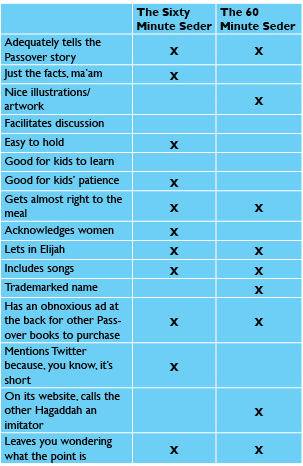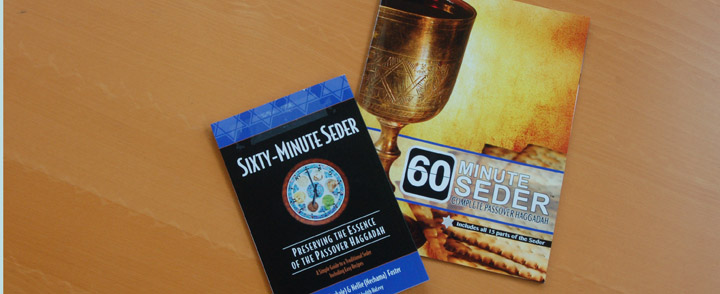By Joel Magalnick, Editor, The Jewish Sound
When “The Sixty Minute Seder” came across my desk a few weeks back, I didn’t give it much thought. When, not much later, a bigger, prettier “The 60 Minute Seder” landed in roughly the same spot, I thought maybe the publishers had, curiously, printed a larger version. Once I actually gave them a look, I realized these Haggadot are very, very different creatures. Given that two different sets of authors came up with the idea of formalizing a seder in under an hour, how could I not put them head to head?
 So here we go: The showdown. Let’s start off with two competing, very different thoughts. First, the idea that someone would actually create a book that basically skips over the discussion, the learning, the richness of the story of the Exodus offends my sensibilities. Who do these people think they are that they can pick and choose for us what gets included in our meal and what doesn’t? Isn’t that our grumpy father’s job? But let’s be honest. From my childhood, at every seder I’ve ever attended, I have thumbed through the Haggadah to find exactly which page the meal is served, then counted the minutes until we got there.
So here we go: The showdown. Let’s start off with two competing, very different thoughts. First, the idea that someone would actually create a book that basically skips over the discussion, the learning, the richness of the story of the Exodus offends my sensibilities. Who do these people think they are that they can pick and choose for us what gets included in our meal and what doesn’t? Isn’t that our grumpy father’s job? But let’s be honest. From my childhood, at every seder I’ve ever attended, I have thumbed through the Haggadah to find exactly which page the meal is served, then counted the minutes until we got there.
Admittedly, some seder leaders do a great job of keeping us engaged, exercising our minds, asking us to consider the story in different ways from what we read on the page. And plenty of you love to talk and sing until all hours of the night.
Sound familiar? Then these books are not for you.
So what do they offer aside from the knowledge that whoever actually goes out and purchases one (or many) of these guides that they’ve satisfied whatever obligation needs to be satisfied before digging into the gefilte fish? Not a lot.
“The Sixty Minute Seder,” by Cass (Yichezkale) and Nellie (Nechama) Foster (Six Points Press, $13.95), much like most Haggadot, reads from right to left. The book itself runs about 60 pages, half of them devoted to the bare minimum of the 15 items that make the seder complete. There’s a little Hebrew, but most everything’s in transliteration for the non-Hebrew readers. That may make some of you uncomfortable, but if you’re welcoming in the stranger, what’s more welcoming than Hebrew in English? Score one for the Fosters. The other half consists of recipes, songs, a glossary, and a book-order form.
The Fosters do offer a page of discussion about the seder — at the back of the book. Don’t blink or you’ll miss it. Artwork consists of clip art and a handful of photos. The dimensions, similar to the old Maxwell House standby, make it easy to hide this under your plate during mealtime.
“The 60 Minute Seder,” by Robert Kopman and Bill Yanok (self-published, $10.95), which, mystifyingly, has been trademarked, is one of the first I’ve come across that reads from left to right. It’s filled with colorful stock photos of deserts and other Passover-related images, drawings, and far more text for participants to read. The imagery is generally nice from page to page, but as a whole feel so different from one another that it doesn’t feel like they have a unifying style or theme. This Haggadah’s dimensions are much larger — 8-1/2 x 11” — so balancing that with a glass of wine or your Hillel sandwich may be a challenge.
If you had to choose between the two, I’d recommend, well, neither. If you do the seder out of obligation and just want to get it out of the way, chances are you’ve got your grandparents’ Haggadot in a box in the attic somewhere. Dig those out, skip the boring stuff, and get to the meal.
If you feel like you want to learn more about the Exodus, you want to ruminate over the four questions, you want to discuss whether the wicked child was truly wicked or just really smart, you’re not going to find that here. Sorry, folks.
